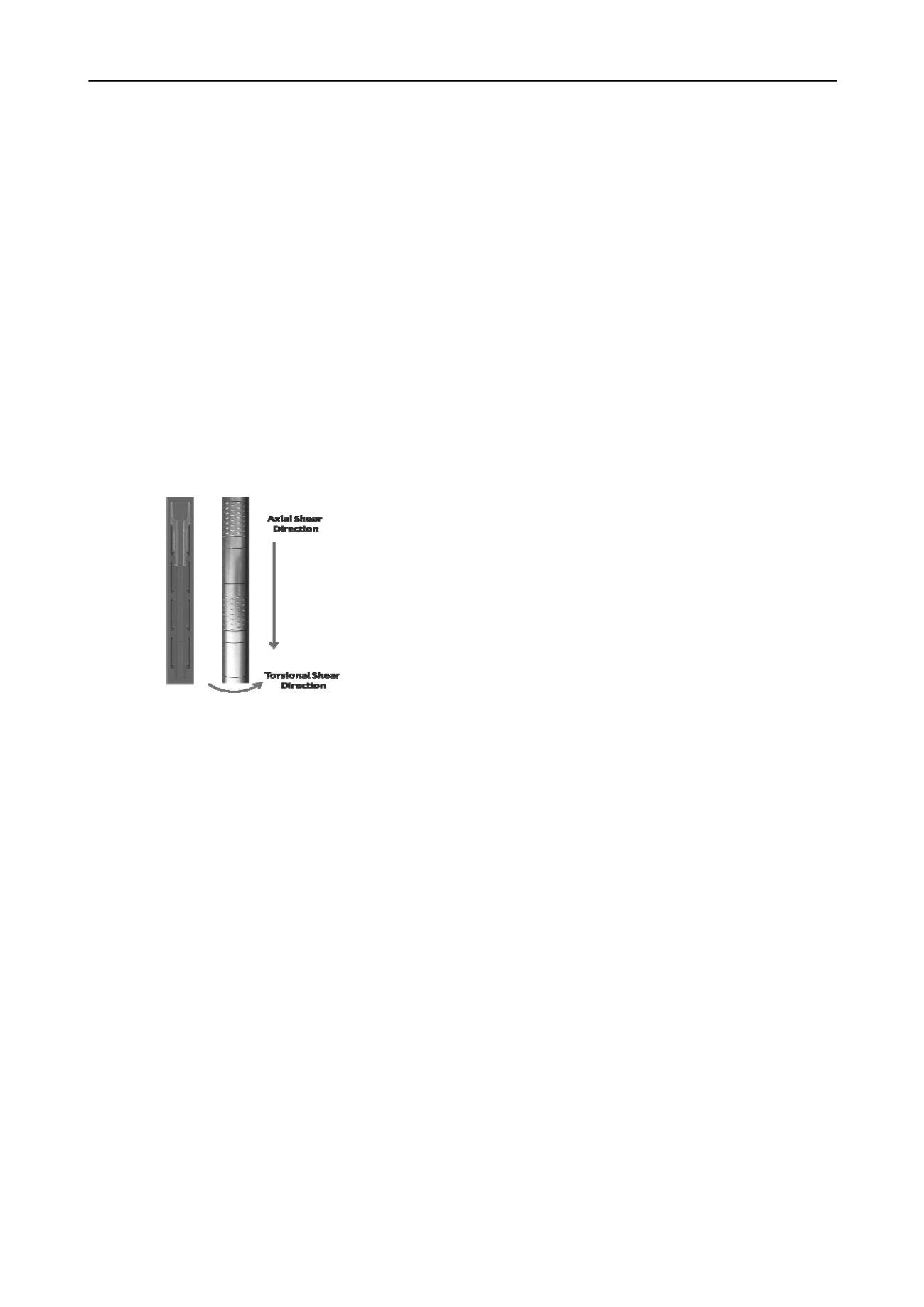
530
Proceedings of the 18
th
International Conference on Soil Mechanics and Geotechnical Engineering, Paris 2013
4 CONCLUSIONS
Significant advances have been made in the last four
decades in the design, use and interpretation of the results
from penetrometer devices used for subsurface
characterization. Similarly, over the past two decades,
significant new insight has been developed into the role of
surface roughness on the behavior of geotechnical interfaces.
An emerging family of innovative devices has been
developed in the last decade that leverages the advances in
performance of penetrometer devices with the new
understanding of interface behavior to produce multi-sleeve
devices that allow for direct in-situ determination of the
relationship between surface roughness and interface shear
as well as the development of shear induced pore pressures
when surfaces of various roughness are sheared against soils.
A unique aspect of this family of devices is the use of
multiple friction sleeves with surface of different roughness
in the same sounding so that the effects of material
variability can be isolated and/or eliminated. To date, all
these devices rely on response of soils during axial
penetration.
Figure 6. Schematic and photograph of multi-sleeve piezo- friction-
torque penetrometer showing load application modes.
This paper describes the development of a new device that
embodies the attributes of the existing multi-sleeve devices
but incorporates the ability to also conduct torsional friction
penetrometer tests in the same sounding. In contrast to
existing vane shear type devices which involve the
application of a torsional force to a rigid central shaft and
measure the resistance to rotation of a set of blades in a soil,
the new device enables measurement of torsional resistance
with the same textured sleeves used in the axial stage of the
test. This is possible through the use of an innovative
electro-mechanical system that allows independent
measurements of axial and torsional resistance of the sleeves
of the penetrometer device. The availability of
complimentary axial and torsional shear forces along with
the associated pore pressures generated by friction sleeves of
different surface roughness represents a potential “disruptive
technology” in the in-situ characterization of soil properties
ranging from soil type to soil strength and deformation
properties to assessment of the in-situ state of stress and
associated parameters such as the in-situ stress ratio.
Significant opportunities exist for dramatic advances in
subsurface investigation. Single sensor historical precedent
has guided the design and configuration of in-situ devices,
there are clear advantages to developing multiple sensor
systems for future investigation studies.
The recent development of various configurations of multi-
sensor systems including the previously presented
generation 1 MFA and generation 2 MPFA as well as the
proposed generation 3 MPFTA device introduced herein
represent a significant departure from traditional practice.
Amongst the benefits of the latter device are:
i) Up to sixteen independent measures of interface shear
ranging from smooth surface sliding to textured surface soil
shearing can be realized in a single sounding in contrast to
the three measures possible with conventional cone
penetration systems.
ii) The effects of different vertical and horizontal stress
states on measured sleeve stresses can be accounted for by
means of the axial and torsional interface stress response.
iii) The procedure for performing combined axial-torsional-
piezo penetration testing of the subsurface using the
proposed MPFTA system involves a series of steps which
allows them to be readily controlled from a remote location
and to be performed using robotic systems.
5 ACKNOWLEDGEMENTS
The initial device development reported herein was funded
in part by a grant from the US National Science Foundation
to the Georgia Tech Research Corporation under Contract #
CMS 9978630.
6 REFERENCES
Chandler, R.J. (1998). “The in-situ measurements of the undrained
shear strength using the field vane”,
Vane Shear Strength
Testing in Soils. Field and Laboratory Studies
. A.F. Richards
(ed.), ASTM STP 1014, ASTM, Philadelphia, pp. 13-44.
DeJong, J.T. (2001). “Investigation of Particulate-Continuum
Interface Mechanics and Their Assessment Through a Multi-
Friction Sleeve Penetrometer Attachment”,
PhD Dissertation,
Georgia Institute of Technology
, Atlanta, May, 360 pp.
DeJong, J.T. and Frost, J.D. (2002). “A Multi-Friction Sleeve
Attachment for the Cone Penetrometer,”
ASTM Geotechnical
Testing Journal,
25, No. 2, pp. 111-127.
DeJong, J.T., Frost, J.D., and Cargill, P.E. (2001). “Effect of
Surface Texturing on CPT Friction Sleeve Measurements.”
Journal of Geotechnical and Geoenvironmental Engineering
,
127, No. 2, pp. 158-168.
Frost, J.D., and DeJong, J.T. (2005) “In Situ Assessment of the Role
of Surface Roughness on Interface Response,”
Journal of
Geotechnical and Geoenvironmental Engineering
, 131, No. 4,
pp. 498-511.
Frost, J.D., Hebeler, G.L., and Martinez, A., (2012), “Cyclic Multi-
piezo-friction Sleeve Penetrometer Testing for Liquefaction
Assessment”, Proceedings of 4
th
International Conference
(ISC’4)
on
Geotechnical
and
Geophysical
Site
Characterization, Pernambuco, Brazil, Vol. 1, pp. 629-636.
Hebeler, G.L. (2005). “Multi Scale Investigations of Interface
Behavior
.
”
PhD Dissertation
. Georgia Institute of Technology,
Atlanta, August, 772 pp.
Hebeler, G.L., and Frost, J.D., (2006), “A Multi Piezo-Friction
Attachment for Penetration Testing”,
Proceedings of ASCE
Geo-Institute Congress: Geotechnical Engineering in the
Information Technology Age
, Atlanta, CD ROM.
Uesugi, M. and Kishida, H., (1986) “Frictional Resistance at Yield
Between Dry Sand and Mild Steel.”
Soils and Foundations
,
Vol. 26, No. 4, pp. 139-149.


